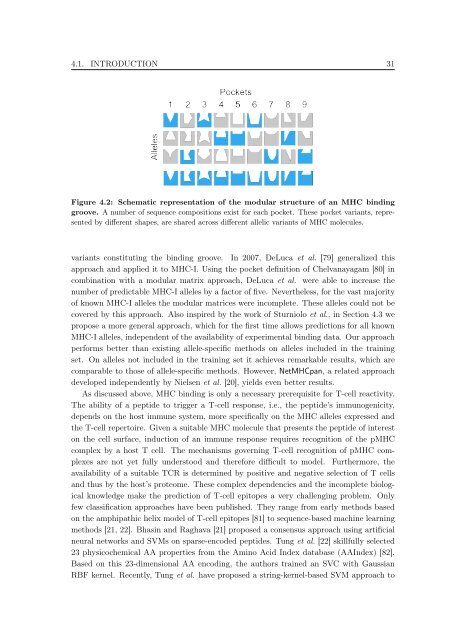New Approaches to in silico Design of Epitope-Based Vaccines
New Approaches to in silico Design of Epitope-Based Vaccines
New Approaches to in silico Design of Epitope-Based Vaccines
Create successful ePaper yourself
Turn your PDF publications into a flip-book with our unique Google optimized e-Paper software.
4.1. INTRODUCTION 31<br />
Figure 4.2: Schematic representation <strong>of</strong> the modular structure <strong>of</strong> an MHC b<strong>in</strong>d<strong>in</strong>g<br />
groove. A number <strong>of</strong> sequence compositions exist for each pocket. These pocket variants, represented<br />
by different shapes, are shared across different allelic variants <strong>of</strong> MHC molecules.<br />
variants constitut<strong>in</strong>g the b<strong>in</strong>d<strong>in</strong>g groove. In 2007, DeLuca et al. [79] generalized this<br />
approach and applied it <strong>to</strong> MHC-I. Us<strong>in</strong>g the pocket def<strong>in</strong>ition <strong>of</strong> Chelvanayagam [80] <strong>in</strong><br />
comb<strong>in</strong>ation with a modular matrix approach, DeLuca et al. were able <strong>to</strong> <strong>in</strong>crease the<br />
number <strong>of</strong> predictable MHC-I alleles by a fac<strong>to</strong>r <strong>of</strong> five. Nevertheless, for the vast majority<br />
<strong>of</strong> known MHC-I alleles the modular matrices were <strong>in</strong>complete. These alleles could not be<br />
covered by this approach. Also <strong>in</strong>spired by the work <strong>of</strong> Sturniolo et al., <strong>in</strong> Section 4.3 we<br />
propose a more general approach, which for the first time allows predictions for all known<br />
MHC-I alleles, <strong>in</strong>dependent <strong>of</strong> the availability <strong>of</strong> experimental b<strong>in</strong>d<strong>in</strong>g data. Our approach<br />
performs better than exist<strong>in</strong>g allele-specific methods on alleles <strong>in</strong>cluded <strong>in</strong> the tra<strong>in</strong><strong>in</strong>g<br />
set. On alleles not <strong>in</strong>cluded <strong>in</strong> the tra<strong>in</strong><strong>in</strong>g set it achieves remarkable results, which are<br />
comparable <strong>to</strong> those <strong>of</strong> allele-specific methods. However, NetMHCpan, a related approach<br />
developed <strong>in</strong>dependently by Nielsen et al. [20], yields even better results.<br />
As discussed above, MHC b<strong>in</strong>d<strong>in</strong>g is only a necessary prerequisite for T-cell reactivity.<br />
The ability <strong>of</strong> a peptide <strong>to</strong> trigger a T-cell response, i.e., the peptide’s immunogenicity,<br />
depends on the host immune system, more specifically on the MHC alleles expressed and<br />
the T-cell reper<strong>to</strong>ire. Given a suitable MHC molecule that presents the peptide <strong>of</strong> <strong>in</strong>terest<br />
on the cell surface, <strong>in</strong>duction <strong>of</strong> an immune response requires recognition <strong>of</strong> the pMHC<br />
complex by a host T cell. The mechanisms govern<strong>in</strong>g T-cell recognition <strong>of</strong> pMHC complexes<br />
are not yet fully unders<strong>to</strong>od and therefore difficult <strong>to</strong> model. Furthermore, the<br />
availability <strong>of</strong> a suitable TCR is determ<strong>in</strong>ed by positive and negative selection <strong>of</strong> T cells<br />
and thus by the host’s proteome. These complex dependencies and the <strong>in</strong>complete biological<br />
knowledge make the prediction <strong>of</strong> T-cell epi<strong>to</strong>pes a very challeng<strong>in</strong>g problem. Only<br />
few classification approaches have been published. They range from early methods based<br />
on the amphipathic helix model <strong>of</strong> T-cell epi<strong>to</strong>pes [81] <strong>to</strong> sequence-based mach<strong>in</strong>e learn<strong>in</strong>g<br />
methods [21, 22]. Bhas<strong>in</strong> and Raghava [21] proposed a consensus approach us<strong>in</strong>g artificial<br />
neural networks and SVMs on sparse-encoded peptides. Tung et al. [22] skillfully selected<br />
23 physicochemical AA properties from the Am<strong>in</strong>o Acid Index database (AAIndex) [82].<br />
<strong>Based</strong> on this 23-dimensional AA encod<strong>in</strong>g, the authors tra<strong>in</strong>ed an SVC with Gaussian<br />
RBF kernel. Recently, Tung et al. have proposed a str<strong>in</strong>g-kernel-based SVM approach <strong>to</strong>

















